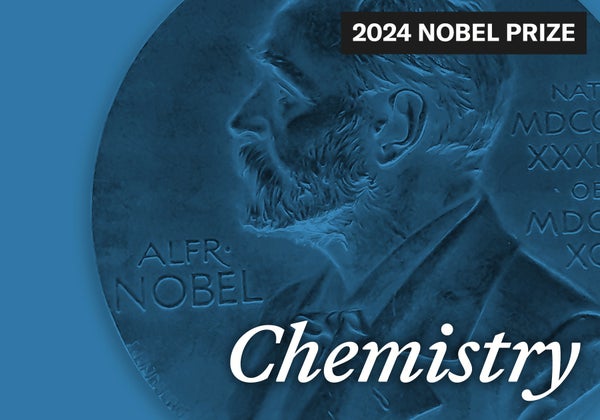October 9, 2024
4 min read
2024 Chemistry Nobel Awarded for Cracking the Secret Code of Proteins
The Nobel Prize in Chemistry goes to biochemist David Baker, and Google DeepMind scientists Demis Hassabis and John Jumper, for predicting protein shapes and functions— and for creating entirely new ones that can improve health and the environment

vanbeets/Getty Images (medal)
The 2024 Nobel Prize in Chemistry was awarded on Wednesday to three scientists for discovering how proteins—the building blocks of life and the dynamos that let cells function—do their jobs. Proteins build muscles and brains, help hearts beat on time and filter out poisons, among many other essential tasks.
Half of the Nobel went jointly to researchers Demis Hassabis and John Jumper, both at Google DeepMind in London, for developing AlphaFold2—an artificial intelligence program that can predict a protein molecule’s shape and structure from its chemical building blocks, called amino acids. Because a protein’s shape determines its function, these predictions are incredibly important.
The other half of the prize went to structural biologist David Baker of the University of Washington for figuring out ways to design entirely new proteins—molecules never seen in nature. Some of these artificial proteins can serve as minuscule sensors while others may block the coronavirus that causes COVID. Baker will get 50 percent of the prize money, 11 million Swedish kronor, or about $1 million. Hassabis and Jumper will get the other 50 percent.
On supporting science journalism
If you’re enjoying this article, consider supporting our award-winning journalism by subscribing. By purchasing a subscription you are helping to ensure the future of impactful stories about the discoveries and ideas shaping our world today.
Because proteins are such basic workhorses in biology, the ability to design artificial ones is “absolutely mind-blowing,” said Johan Åqvist, a member of the Nobel Committee for Chemistry, at a press conference following the announcement. Baker, awakened by a phone call from Sweden, said he was “very excited and very honored” to get the prize and that he “stood on the shoulders of giants.” Such researchers include Christian Anfinsen, a U.S. scientist who received the 1972 chemistry Nobel after discovering that proteins’ shape was almost entirely determined by their sequence of amino acids. (Baker also said that when he told his wife it was the Nobel Prize committee on the other end of the line, she yelled so loudly with excitement that he missed some of the details about who had won what.)
Forms of AI have now racked up two Nobel Prizes in two days. Scientists who worked in the 1980s and 1990s to develop artificial neural networks, a type of machine learning that helped pave the way for more recent AI, won the award in physics on Tuesday. “AI has had a transformational impact,” says Amanda Morris, a synthetic organic chemist at Virginia Tech. “It will just speed up the rate of discovery.” She notes that traditional methods such as x-ray crystallography had predicted only a relative few proteins’ structures, and little about what they did and how they did it. In contrast, the AlphaFold2 program scored about 90 on a 100-point scale of accuracy in a 2020 structure-prediction competition. The program was able to predict the 3D structure of about 200 million proteins by 2022.
Hassabis told Scientific American in a 2022 interview that the AI appears to understand the various forces that attract and repel the amino acid components to and from one another. Those forces move and twist a protein into specific configurations that the AI can forecast. And these forecasts allow researchers to investigate using the proteins to develop new pharmaceuticals, for instance.
Morris says she is interested in the type of designer proteins coming from Baker’s work. She is using some of the proteins involved in photosynthesis to develop renewable energy sources. As part of the photosynthetic process, such proteins strip electrons from water, which frees the electrons to be harvested for other energy uses. “The trouble is: these proteins fall apart easily,” she says. But “if we could build artificial ones from more stable materials, we might be able to turn this into a renewable energy process that works better than nature.”
Among the artificial proteins that Baker is most excited about, he says, are molecules that block the way the COVID-causing coronavirus, SARS-CoV-2, infects human cells. He and his team were able to engineer these proteins at such a small size that they could be delivered in a nasal spray rather than with the traditional shot in the arm, he told Scientific American in a 2021 article. Making these “mini binders,” as he and his team call them, would have been impossible before he and other scientists deduced some of the fundamental rules that pull certain amino acids together and push others apart, determining the shape of a protein and thus how it interacts with other molecules, such as components of a virus.
In 2020, as Baker stood alongside a stage at a scientific meeting, waiting to speak on a panel about protein design that I was moderating, he told me that he much prefers working in the lab on new molecules rather than giving public speeches. With all the advantages of Nobel recognition, however, come demands on a winner’s time. And Baker’s time in the lab will probably be limited during the next several months, at least until after the December awards ceremony in Stockholm.



